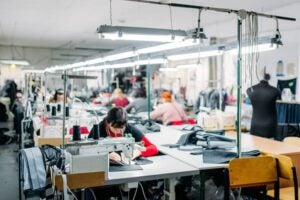Is fast fashion slowing down? How global trade, AI can be used as forces for good

In the world of fast fashion, where trends are born as quickly as they are discarded, global trade regulations have struggled to keep pace and address the troubling reality hiding behind the industry’s glamorous façade: a supply chain tainted by human rights abuses and forced labor.
USC experts discuss how global trade regulations, consumer demands, and technological advancements are bringing human rights to the forefront of the changing textile industry.
Contact: Nina Raffio, raffio@usc.edu or (213) 442-8464
Confronting fast fashion’s toll on migrants and women
 “The fast fashion industry openly admits to creating disposable products with no apologies. But it’s crucial to include labor in the definition of sustainability because people are an integral part of our environment,” said Annalisa Enrile, a teaching professor at the USC Suzanne Dworak-Peck School of Social Work.
“The fast fashion industry openly admits to creating disposable products with no apologies. But it’s crucial to include labor in the definition of sustainability because people are an integral part of our environment,” said Annalisa Enrile, a teaching professor at the USC Suzanne Dworak-Peck School of Social Work.
Enrile — an expert in global justice, human trafficking and exploitative labor — sheds light on the plight of migrant women, who constitute a significant portion of the global labor force.
“Anywhere you have large-scale migration, you will also have a higher rate of labor exploitation. These countries often have export processing zones where factories are built with different laws and standards to attract businesses,” she said.
“It’s a massive scope, with thousands of people migrating for labor every day, leading to entire villages in developing countries without women,” Enrile said, adding that gender-based violence in the fashion industry is well-documented, primarily driven by male supervisors who enforce unreasonable production targets imposed by fashion brands.
Contact: enrile@usc.edu
Conscious consumers drive fashion toward social responsibility
 “The accessibility of information has brought to light the ethical concerns around product sourcing. We’re seeing a preference for not just fair trade, but direct trade and more conscious and socially aware consumerism,” said Elizabeth Currid-Halkett, the James Irvine chair in urban and regional planning and professor of public policy at the USC Price School of Public Policy.
“The accessibility of information has brought to light the ethical concerns around product sourcing. We’re seeing a preference for not just fair trade, but direct trade and more conscious and socially aware consumerism,” said Elizabeth Currid-Halkett, the James Irvine chair in urban and regional planning and professor of public policy at the USC Price School of Public Policy.
Consumers value the origin of products, showing a preference for goods hailing from regions known for their quality, Currid-Halkett explained. An example of this is the resurgence in American manufacturing, especially the Made in the USA movement prominent in high-end denim and loungewear such as T-shirts and sweatshirts.
“It holds great importance for the American economy as it reflects a sense of social consciousness around our purchasing decisions. When a product is made in the USA, made in LA, or made in Brooklyn, part of its appeal lies in knowing where it comes from and who is making it,” she said.
Contact: currid@usc.edu
The future of fashion—and supply chain transparency—is digital
 Nick Vyas, an associate professor at the USC Marshall School of Business and an expert in global supply chain management, sees great promise in artificial intelligence to revolutionize business processes within the global fashion industry.
Nick Vyas, an associate professor at the USC Marshall School of Business and an expert in global supply chain management, sees great promise in artificial intelligence to revolutionize business processes within the global fashion industry.
Generative AI can improve better supply chain visibility by tracking inventory through RFID tags and IoT sensors. AI-powered decision-making can help companies select suppliers based on performance, certificates, and data analysis, ensuring ethical sourcing practice.
“The prevailing economic headwinds should accelerate our investment in emerging technologies that enhance efficiency and promote sustainability,” Vyas said. “As we navigate these tumultuous times, the key to resilience lies not in resisting change but in embracing it.”
Contact: nikhilvy@marshall.usc.edu
###



